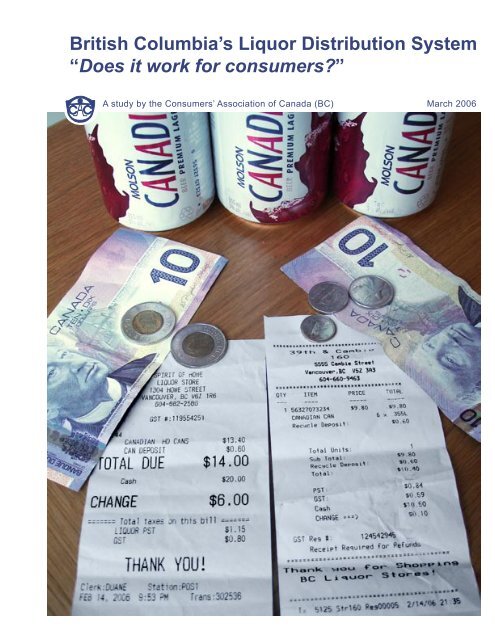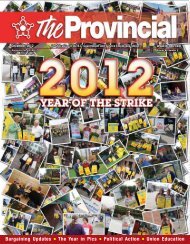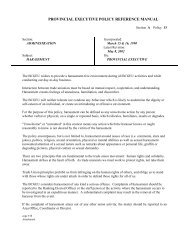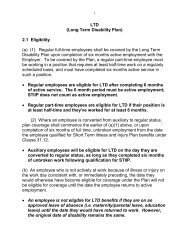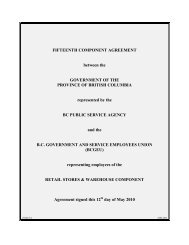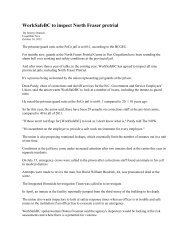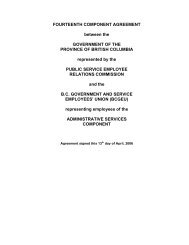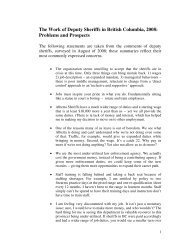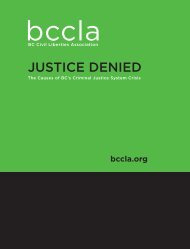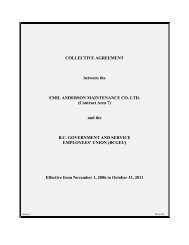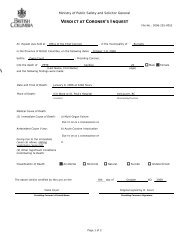British Columbia's Liquor Distribution System - Consumers ...
British Columbia's Liquor Distribution System - Consumers ...
British Columbia's Liquor Distribution System - Consumers ...
Create successful ePaper yourself
Turn your PDF publications into a flip-book with our unique Google optimized e-Paper software.
<strong>British</strong> Columbia’s <strong>Liquor</strong> <strong>Distribution</strong> <strong>System</strong>“Does it work for consumers?”A study by the <strong>Consumers</strong>’ Association of Canada (BC) March 2006
about the associationService to <strong>British</strong> Columbia <strong>Consumers</strong>Since 1947 the <strong>Consumers</strong>’ Association of Canada (BC) has served the interests of consumersin <strong>British</strong> Columbia. The Association provides a strong independent consumer voice whengovernment and industry make decisions that substantially affect the public. The Associationrepresents the consumer’s point of view to the media, government and corporations on issuesrelated to safety, price, quality of service and products.CAC (BC) is a non-profit organization supported by a network of volunteer members whoconduct research and advocate on behalf of consumers via Advisory Boards, Commissions andStanding Committees. The Association submits briefs on consumer issues to governments andhas assisted thousands of individual consumers in resolving disputes with product and serviceproviders.Consumer AdvocacyThroughout its history, the Association has advocated consumers’ interests in government andcorporate decisions and been a catalyst for consumer action on issues such as:• Contaminated food products and safety of the Canadian food supply;• Beverage container recycling and deposits;• Auto insurance and industry practises;• Genetically Modified foods;• Safety standards for children’s car seats;• Bans on hazardous pesticides;• Restricted selling practices for funeral services;• Restriction of cable TV’s negative-option marketing practices;Governments set important rules that shape the beverage alcohol marketplace. The CAC’sobjective in this study is to assess how changes to these rules affect consumer interests.AcknowledgementThe <strong>Consumers</strong> Association of Canada (BC) gratefully acknowledges information provided bythe owners and managers of private liquor stores in the province of <strong>British</strong> Columbia duringpreparation of this study. All comments, analysis, findings and conclusions in this study arethe sole responsibility of the Association.
BBr ri iit tti iisshh CCool lluummbbi iiaa’ ’’ss LLi iiqquuoor r DDi iisst ttr ri iibbuut tti iioonn SSy ysst tteemm –– DDooeess iit itt WWoor rkk FFoor r CCoonnssuummeer rss??MMaar rcchh 22000066executive summaryIn July 2002 the <strong>British</strong> Columbia government announced that it would close all governmentownedliquor stores and warehouses, replacing these with privately owned retail stores andwarehouses. This annoucement resulted in a backlash of comment from community groupsand local governments. In 2003 the Association conducted a comparison of Alberta’s privatesystem vs. <strong>British</strong> Columbia’s and concluded that the importation of the Alberta privatizationmodel would result in more stores across the province but prices would be higher and therewould be less product selection in small private stores.In 2004 the BC Government made a dramatic shift in its announced privatization policy – itwould now implement a dual path strategy – in effect, a form of “creeping privatization”. Underthis strategy some government liquor stores would close and few new ones would open whilethe Government would allow a massive increase in new private liquor stores.This study examines the new BC liquor store model – how the changes in the existing liquordistribution model by the <strong>British</strong> Columbia government impacted retail prices, productselection and availability, and the design, location and number of new private liquor stores. Thestudy uses information obtained from field research of private liquor stores in <strong>British</strong> Columbiato evaluate the impacts of a privatized liquor store model throughout <strong>British</strong> Columbia.Prices were obtained directly from private liquor stores and published retail and wholesaleprice lists. All data was adjusted for issues such as bottle deposits and GST. In total, price datawas collected on 43 different products representing a cross section of the most popularproducts sold in the province. This data was collected from private liquor stores in 34communities in <strong>British</strong> Columbia and compared with prices at government liquor stores in theprovince.Key Findings and Conclusions1. The BC Government’s privatization of liquor sales has forced consumers to paymillions of dollars more for beer, wine and liquor.2. There has been a massive proliferation of private liquor stores across the province.3. There is less product selection at individual private liquor stores.4. Prices for products sold by <strong>British</strong> Columbia Government liquor stores are about thesame as those at similar stores operated by The Government of Ontario, the largestpurchaser of alcoholic beverages in North America.©© 22000066 CCoonnssuummeer rss’ ’’ AAssssoocci iiaat tti iioonn oof ff CCaannaaddaa 2
BBr ri iit tti iisshh CCool lluummbbi iiaa’ ’’ss LLi iiqquuoor r DDi iisst ttr ri iibbuut tti iioonn SSy ysst tteemm –– DDooeess iit itt WWoor rkk FFoor r CCoonnssuummeer rss??MMaar rcchh 22000066study overviewCanadian provincial governments closely control the pricing and sale of beverage alcohol tostrike a balance between consumption (via hours of service, number of outlets and pricing),ensuring consumers have access to products, and collecting significant tax revenues. In allprovinces Governments are the sole wholesaler of all alcohol products and in all save oneprovince the provincial Government also owns and manages a retail distribution system.In Canada the retail distribution function has devolved to some degree. This ranges fromQuebec permitting the sale of wine at local corner convenience stores to the full privatization ofAlberta’s liquor stores to <strong>British</strong> Columbia’s dual private/public store model. A review of theprivatization model has also occurred in Ontario where it was recommended by anindependent panel but rejected by the Ontario Government as not being in the consumers’interest.This study deals with a specific part of the liquor issue in <strong>British</strong> Columbia – how the new retaildistribution model for retail liquor distribution has impacted consumers with respect to retailprices, product selection and availability, and the design, location and number of new privateliquor stores.Many BC consumers want to know and this study answers two key questions, namely;1. Do consumers pay more or less for beer, wine and spirits in private liquor stores thanat government liquor stores in <strong>British</strong> Columbia?”2. How does product selection compare at private vs. government liquor stores?This study surveyed private stores across large and small communities in the province asindicated in the chart below.Brentwood Bay Langford PrincetonBurnaby Langley RichmondChase Maple Ridge SaanichtonChemainus Mission Salmon ArmChilliwack Nanaimo SookeCobble Hill New Westminster SummerlandColwood North Vancouver SurreyCoombs Parksville VancouverCoquitlam Peachland VernonDuncan Penticton VictoriaHope Port Alberni West VancouverKamloopsPort Coquitlam©© 22000066 CCoonnssuummeer rss’ ’’ AAssssoocci iiaat tti iioonn oof ff CCaannaaddaa 3
BBr ri iit tti iisshh CCool lluummbbi iiaa’ ’’ss LLi iiqquuoor r DDi iisst ttr ri iibbuut tti iioonn SSy ysst tteemm –– DDooeess iit itt WWoor rkk FFoor r CCoonnssuummeer rss??MMaar rcchh 22000066In addition the study examines other issues of interest such as a comparison of publishedprices between the <strong>British</strong> Columbia and Ontario Government liquor stores.A list of products surveyed in this study follows. 43 products were selected that would act asan indicator of prices at private and government owned liquor stores in <strong>British</strong> Columbia. Theproducts selected for this study were selected using the following criteria:1. The products represented a cross-section of major national brands2. The products were big sellers representative of their product category3. The products were likely to be in stock, and available for purchase in a significantnumber of private and government stores©© 22000066 CCoonnssuummeer rss’ ’’ AAssssoocci iiaat tti iioonn oof ff CCaannaaddaa 4
BBr ri iit tti iisshh CCool lluummbbi iiaa’ ’’ss LLi iiqquuoor r DDi iisst ttr ri iibbuut tti iioonn SSy ysst tteemm –– DDooeess iit itt WWoor rkk FFoor r CCoonnssuummeer rss??MMaar rcchh 22000066Product#DescriptionBEERSList of Products SurveyedProduct#DescriptionWINES cont.1 Labatts Blue (6 cans) 23 Black Tower White (0.75 L)2 Labatts Blue (15 cans) 24 E & J Gallo Cab. Sauvignon (0.75 L)3 Budweiser (12 cans) 25 Mondavi Chard: Woodbridge (0.75 L)4 Molson Canadian (6 cans) 26 Andres Baby Champagne (0.75 L)5 Molson Canadian (12 cans) 27 Henkell Trocken (0.75 L)6 Kokanee (12 cans)7 Corona Extra (6 bottles) SPIRITS8 Heineken (12 bottles) 28 Beefeater Gin (0.75 L)9 Moosehead Lager (6 bottles) 29 Gordon Gin (1.14 L)10 Guinness Stout (6 bottles) 30 Tanqueray Gin (0.75 L)11 Sleeman Cream Ale (6 bottles) 31 Captain Morgan Spiced Rum (0.75 L)12 Big Rock Grasshopper (6 bottles) 32 Lamb’s Navy (1.14 L)13 Newcastle Brown Ale (6 bottles) 33 Alberta Vodka (0.75 L)34 Finlandia Vodka (1.14 L)COOLERS & CIDERS 35 Absolut Vodka(1.14 L)14 Mike’s Hard Lemonade (4 bottles) 36 Canadian Club (0.75 L)15 Strongbow Cider (4x275ml bottles) 37 Crown Royal (1.14 L)38 Seagram’s 5 Star (1.14 L)WINES 39 Chivas Regal (0.75 L)16 Domain D’Or White (1.5 L) 40 Glenlivet (0.75 L)17 Domain D’Or Red (1.5 L) 41 Johnnie Walker Black (0.75 L)18 Gray Monk Pinot Noir (0.75 L)19 Jackson Triggs Cab. Sauvignon (0.75L)LIQUORS20 Sawmill Creek Chard. (0.75 L) 42 Amoretto di Saronno (0.75 L)21 Sawmill Creek Chard. (1.5 L) 43 Bailey’s Irish Cream (1.14 L)22 Piat D’Or White (0.75 L)©© 22000066 CCoonnssuummeer rss’ ’’ AAssssoocci iiaat tti iioonn oof ff CCaannaaddaa 5
BBr ri iit tti iisshh CCool lluummbbi iiaa’ ’’ss LLi iiqquuoor r DDi iisst ttr ri iibbuut tti iioonn SSy ysst tteemm –– DDooeess iit itt WWoor rkk FFoor r CCoonnssuummeer rss??MMaar rcchh 22000066key findingsFINDING #1The BC Government liquor store model has forced consumers to paymillions of dollars more at private liquor stores for beer, wine and liquorBC consumers pay tens of millions more dollars per year when they shop at private liquorstores.The Charts below illustrates how much higher the prices of 43 major beer, wine and spiritsproducts sold at private liquor stores in <strong>British</strong> Columbia compared to the price of the sameproducts sold at <strong>British</strong> Columbia government liquor stores.Private liquor store prices for the same product were consistently more expensive thangovernment liquor stores.Chart 1Charts 2 and 3 illustrate the price differences between private and government stores of twovery popular products.©© 22000066 CCoonnssuummeer rss’ ’’ AAssssoocci iiaat tti iioonn oof ff CCaannaaddaa 6
BBr ri iit tti iisshh CCool lluummbbi iiaa’ ’’ss LLi iiqquuoor r DDi iisst ttr ri iibbuut tti iioonn SSy ysst tteemm –– DDooeess iit itt WWoor rkk FFoor r CCoonnssuummeer rss??MMaar rcchh 22000066Chart 2Chart 3©© 22000066 CCoonnssuummeer rss’ ’’ AAssssoocci iiaat tti iioonn oof ff CCaannaaddaa 7
BBr ri iit tti iisshh CCool lluummbbi iiaa’ ’’ss LLi iiqquuoor r DDi iisst ttr ri iibbuut tti iioonn SSy ysst tteemm –– DDooeess iit itt WWoor rkk FFoor r CCoonnssuummeer rss??MMaar rcchh 22000066Currently, the <strong>British</strong> Columbia government provides a price discount of 13% off the listed retailprices to private liquor stores for products available through a government liquor store. TakingAlberta’s private liquor store experience is a guide; this level of gross profit is inadequate tosustain this type of business. As a result prices must be higher for consumers shopping atprivate stores.Private liquor store owners surveyed confirmed this (Chart 5) as they price their products asclosely as possible to the government stores while attempting to remain competitive butgenerate an adequate margin to sustain their business.This study shows the result is higher prices for consumers at private stores. As the BCGovernment closes more of its own stores consumers are being required to pay premiumprices to have private liquor stores open nearby.CHART 4©© 22000066 CCoonnssuummeer rss’ ’’ AAssssoocci iiaat tti iioonn oof ff CCaannaaddaa 8
BBr ri iit tti iisshh CCool lluummbbi iiaa’ ’’ss LLi iiqquuoor r DDi iisst ttr ri iibbuut tti iioonn SSy ysst tteemm –– DDooeess iit itt WWoor rkk FFoor r CCoonnssuummeer rss??MMaar rcchh 22000066FINDING #2There has been a massive proliferation of private liquor stores across theprovinceAs the chart below illustrates there has been a dramatic number of local private liquor storelicenses granted since the BC Government decided to implement its dual model strategy.CHART 5The number of private liquor stores that have opened can be placed in context by looking atthe growth by store type (Chart 7). Since 2003, the number of Government stores has been indecline which reflects the Government’s plan to cut back on its stores although it is not yetclear how many more will be closed. In the last year six stores have been closed with anothertwelve soon to follow.The number of Licensee Retail Stores (LRS) has seen rapid growth. In addition to theexpansion of the number of private stores these stores also have much longer operating hoursthan is the case with Government stores providing private stores with a competitive advantage.Table 1 below illustrates current operating hours for the private liquor stores surveyed.©© 22000066 CCoonnssuummeer rss’ ’’ AAssssoocci iiaat tti iioonn oof ff CCaannaaddaa 9
BBr ri iit tti iisshh CCool lluummbbi iiaa’ ’’ss LLi iiqquuoor r DDi iisst ttr ri iibbuut tti iioonn SSy ysst tteemm –– DDooeess iit itt WWoor rkk FFoor r CCoonnssuummeer rss??MMaar rcchh 22000066CHART 6Note: Does not include private Rural Agency StoresTABLE 1HOURS AND DAYS OF WEEK OPERATIONPrivate liquor stores in <strong>British</strong> ColumbiaMon-Wed Thursday Friday Saturday SundayOPENINGEarliest 9:00 9:00 9:00 9:00 9:00Latest 11:30 11:30 11:30 11:30 11:30CLOSINGEarliest 11:00 11:00 11:00 10:00 10:00Latest 11:00 11:00 11:00 11:00 11:00©© 22000066 CCoonnssuummeer rss’ ’’ AAssssoocci iiaat tti iioonn oof ff CCaannaaddaa 10
BBr ri iit tti iisshh CCool lluummbbi iiaa’ ’’ss LLi iiqquuoor r DDi iisst ttr ri iibbuut tti iioonn SSy ysst tteemm –– DDooeess iit itt WWoor rkk FFoor r CCoonnssuummeer rss??MMaar rcchh 22000066As part of the survey research for this study private store owners/managers were asked whythey thought consumers choose to purchase product from their store over a Government store.Chart 8 shows their response.CHART 7©© 22000066 CCoonnssuummeer rss’ ’’ AAssssoocci iiaat tti iioonn oof ff CCaannaaddaa 11
BBr ri iit tti iisshh CCool lluummbbi iiaa’ ’’ss LLi iiqquuoor r DDi iisst ttr ri iibbuut tti iioonn SSy ysst tteemm –– DDooeess iit itt WWoor rkk FFoor r CCoonnssuummeer rss??MMaar rcchh 22000066FINDING #3There is less product selection at private liquor stores<strong>Consumers</strong> perceive product selection as being very important - what they can actually buy at astore in terms of the range of types of products available, variety in a product category andproduct size options. Based on the field research of private stores in <strong>British</strong> Columbia it isclear, and no surprise, that product selection is a direct function of liquor store size.Chart 9 illustrates the size of the private liquor stores surveyed, for which there was accuratedata, and compares it to the average size of a government liquor store in <strong>British</strong> Columbia,which is about 6000 sq. feet. The majority of <strong>British</strong> Columbia private stores have a goodselection of beers and as store size increased the number and variety of wines, spirits andspecialty products also increased.Product selection for consumers is substantially less as these 500 -2000 sq. ft. private storesdo not have the space to offer equivalent selection compared to larger 6000 sq. ft.government liquor stores.Chart 8©© 22000066 CCoonnssuummeer rss’ ’’ AAssssoocci iiaat tti iioonn oof ff CCaannaaddaa 12
BBr ri iit tti iisshh CCool lluummbbi iiaa’ ’’ss LLi iiqquuoor r DDi iisst ttr ri iibbuut tti iioonn SSy ysst tteemm –– DDooeess iit itt WWoor rkk FFoor r CCoonnssuummeer rss??MMaar rcchh 22000066FINDING #4Prices for products sold by <strong>British</strong> Columbia Government liquor stores areabout the same at Government liquor stores in OntarioA comparison of BCLDB store prices against <strong>Liquor</strong> Control Board of Ontario (LCBO) pricesshows variation, but overall very similar prices.Chart 9©© 22000066 CCoonnssuummeer rss’ ’’ AAssssoocci iiaat tti iioonn oof ff CCaannaaddaa 13
BBr ri iit tti iisshh CCool lluummbbi iiaa’ ’’ss LLi iiqquuoor r DDi iisst ttr ri iibbuut tti iioonn SSy ysst tteemm –– DDooeess iit itt WWoor rkk FFoor r CCoonnssuummeer rss??MMaar rcchh 22000066As the chart below shows If Ontario also had a private system, such as exists in <strong>British</strong>Columbia, then prices would be higher in Ontario.Chart 10©© 22000066 CCoonnssuummeer rss’ ’’ AAssssoocci iiaat tti iioonn oof ff CCaannaaddaa 14
BBr ri iit tti iisshh CCool lluummbbi iiaa’ ’’ss LLi iiqquuoor r DDi iisst ttr ri iibbuut tti iioonn SSy ysst tteemm –– DDooeess iit itt WWoor rkk FFoor r CCoonnssuummeer rss??MMaar rcchh 22000066conclusionsBased on the findings of this study the <strong>Consumers</strong>’ Association of Canada(BC) has reached the following conclusions:1. The BC Government’s privatization of liquor sales has forced consumers to paymillions of dollars more for beer, wine and liquor.2. There has been a massive proliferation of private liquor stores across the province.3. There is less product selection at individual private liquor stores.4. Prices for products sold by <strong>British</strong> Columbia Government liquor stores are about thesame as those at similar stores operated by The Government of Ontario, the largestpurchaser of alcoholic beverages in North America.©© 22000066 CCoonnssuummeer rss’ ’’ AAssssoocci iiaat tti iioonn oof ff CCaannaaddaa 15


